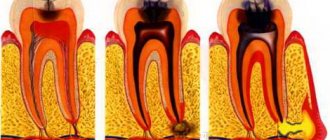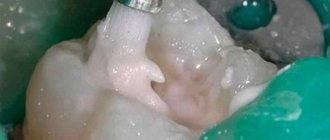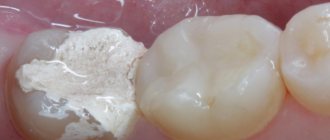Home / Articles / Does the bite change after a filling?
If after treatment you feel discomfort from the filling, then only a specialist can solve the problem. Postponing a visit to the dentist is dangerous, as poor-quality filling can cause:
- inflammation in soft tissue consisting of vessels and bundles of nerve fibers - pulpitis;
- inflammatory process in the gum area - periodontitis;
- mechanical damage to the crown (chip or crack);
- misalignment of the jaw with subsequent dislocation.
Symptoms
Visiting the dentist and getting dental treatment is accompanied by unpleasant sensations and discomfort. Pain can and should be present after therapeutic measures. But it goes away after a short period of time.
If pain persists, then under no circumstances should it be ignored. They will lead to the development of inflammatory processes. The result is a damaged tooth.
Signs of an incorrectly installed seal include:
- Inability to clench or clench teeth. It feels like the filling is too high and protrudes above all the teeth. Therefore, when chewing or moving the jaw, there is a feeling of a foreign object in the mouth.
- A feeling of pain that intensifies when chewing. It occurs due to both over- and under-inflated fillings.
- Sharp or overhanging edges. The filling may have a tight fit to the bite, but at the same time cause injury to the gums or tongue. These injuries can lead to the development of stomatitis.
- Permanent injury to the papilla. This is caused by incorrect actions of the dentist, who did not preserve the interdental gaps during treatment. As a result, it becomes difficult to brush your teeth and your gums begin to bleed.
The norm is the presence of discomfort and pain in the first 3-4 days after dental treatment. Everything should go away on its own after this period. But if the discomfort persists, then you should immediately contact your dentist so that he can eliminate this problem. Most often this takes a few minutes and does not require additional intervention.
Clinic doctors
Dentists in clinics often ask you before filling, “Are we going to get a good filling?”
Well, of course, a good one! And you choose the most expensive filling, and then you are sincerely surprised when it falls out or at the next appointment you are diagnosed with extensive caries underneath it. How so?
Of course, the filling material plays a big role. But even the most expensive filling will not last long if it is placed incorrectly!
It is about the “pitfalls” of installing a filling that we will talk about in this article.
What does careless filling lead to?
Dental filling is the most common and probably familiar dental treatment procedure to every person. But you don’t even suspect how many problems an incorrectly installed filling can cause.
For example, she can:
- simply fall out in a few weeks, or even by evening
- cause discomfort while eating and even at rest
- injure the gums and lead to periodontitis (inflammation of the gums)
Moreover, in some cases, improper filling can even cause jaw pain and headaches!
This is exactly the story our patient told.
“Some time after installing fillings on all the chewing teeth, I noticed that the lower jaw seemed to be “moving” from side to side.
Soon, the unpleasant sensations were supplemented by pain in the cheekbones, and then in the back of the head; while eating, it was painful even just to open my mouth.
As it turned out, all my fillings were made flat! And this led to a violation of the natural position of the jaw. I couldn’t even imagine that this could happen!”
To avoid trouble, remember -
How to determine whether a filling is installed correctly
High-quality installation of fillings meets these criteria.
1. The anatomical surface of the tooth has been restored
That is, a special shape with tubercles and depressions (fissures), thanks to which the teeth perform the main function of grinding and crushing food. And they keep the jaws in the correct position so that the story you just read does not repeat itself.
1. Poor quality filling 2. Correct filling
At the DentaBravo clinic, after treatment, we show the patient the installed filling in a mirror and advise him to listen to his own feelings. You should not feel discomfort when you close your teeth.
2. A point contact point has been formed
Normally, adjacent teeth touch tightly at one point. Therefore, after installing a filling on the side surface of a tooth, there should be no gaps left between adjacent teeth where food debris can accumulate, causing the development of caries below the filling.
And our dentists know for sure that the filling material should not completely fill the space between the teeth, connecting two teeth.
Firstly, then the load on the teeth during chewing is distributed unevenly, and secondly, the filling itself will collapse faster.
If your gums become inflamed and bleed at the place where the filling is placed, and your teeth hurt when chewing, most likely the reason is a poor contact point.
3. The filling material does not hang over the edges of the tooth
If the filling does not exactly follow the contour of the tooth, but protrudes beyond its limits and has uneven edges, then food can again get stuck under it. And this, as you remember, is a direct path to caries.
4. The surface of the filling does not have microvoids or cracks
After installation, the filling is treated with burs and then polished to a perfectly smooth surface. At the same time, microscopic cracks and voids that are invisible to the eye may remain on the surface of the filling.
To get rid of them, we apply a special composite material to the surface of the filling, thanks to which the strength and color of the filling are preserved.
At the DentaBravo clinic, after filling, the doctor will definitely tell you how to care for your teeth in order to preserve the enamel and extend the life of the filling.
A filling made from high-quality material, made using technology, will last from 5-8 to 20 years (!), without causing you any inconvenience. And if the work was done by a dentist without sufficient experience and qualifications, then using even the most expensive material will not fix anything.
Therefore, when going for dental treatment, focus not only on the quality of the material, but also on the professionalism and experience of the doctor - and our advice will help you with this.
If you have already found a dentist you trust, we are very happy! And if not, come to our clinic, where the quality of treatment is guaranteed by specialists with 10 years of experience.
Sign up for a free consultation at the DentaBravo clinic!
Causes of an incorrectly installed seal
After treating a tooth, the dentist must install a filling that will protect and isolate sensitive tissues from bacteria and microbes entering the resulting cavity.
The filling material undergoes a polymerization process and then must be properly sanded. At this stage, the doctor monitors and corrects its fit to the tooth, as well as its position relative to the gums, cheeks, and tongue.
The most common causes of toothache after a filling is installed are:
- Oversized filling.
- The solution has shrunk.
- The treatment procedure was carried out in violation.
- Inflammatory began in the canals.
- Poor quality filling material.
- Allergy.
- Incorrect diagnosis and, accordingly, treatment.
- There was an infection in the dental canals.
Let's find out why a tooth hurts after a temporary filling
To control the protruding edges of the filling material, its position relative to the rest of the teeth and the bite, the dentist uses a special coloring strip. The test is that the patient must bite it several times. If the doctor sees that there are no obstacles, then he begins polishing.
This is a very important stage, because if you make a mistake and do not notice the protruding edges of the filling, they will cause problems with chewing food and oral hygiene, which will lead to the development of negative consequences and various diseases.
How to replace an old filling
After diagnosing the condition of the tooth, treatment is prescribed, determined by the depth of the lesion. In case of minor carious process, the old filling is removed using a drill, the resulting cavity is processed and filled again. The health and longevity of the tooth depend on the doctor’s compliance with the technological process:
- cleaning the cavity from carious tissues;
- correct placement of the filling;
- preservation of the anatomical features of the tooth;
- choosing the color of the filling material;
- tight fit.
If the filling is partially damaged, it is not completely removed; filling material is applied to the defect site to restore its shape and tightness.
What to do
There are several ways that a new filling can cause discomfort. Among them:
- Wrong size. It may be too big or small for the tooth.
- Poorly installed and polished filling. The filling material protrudes from one side of the tooth, causing additional discomfort.
Any of these problems can lead to further tooth decay. It is better not to try to correct the situation on your own, but if you notice the first symptoms, immediately contact your dentist.
The doctor must properly sand the filling material. The adjustment will take a maximum of 5-10 minutes.
Some people are in no hurry to seek help from a specialist because they mistakenly believe that the filling itself will wear off over time and stop causing discomfort. But the modern material that dentists use is more durable. A high-quality filling will shrink and begin to wear off only after a few years.
A filling fell out: what to do before visiting the dentist?
If a permanent filling falls out:
- Before visiting the dentist, periodically rinse with antiseptic agents;
- the chewing load on a damaged tooth should be limited: try to chew on the other side, do not bite off hard foods, etc.;
- When brushing your teeth, do not press the bristles onto the problem area; if possible, it is better not to touch it at all;
- To relieve severe pain, you can take an analgesic.
DentoSpas dentists do not recommend:
- Try to remove the remaining filling material yourself. By removing them, you can damage the walls of the crown or the pulp, causing increased pain;
- put any medicines or remedies inside the tooth. This will not protect against complications, but can worsen the condition of the pulp and dentin;
- try to “close” the hole with cotton wool, gauze, chewing gum, etc. The inflammatory process will go faster if the cavity is not washed with saliva.
If a temporary filling falls out:
- If your appointment with the dentist is only a few days away, contact your doctor and tell him that the temporary filling has broken down. He may reschedule the visit or give additional recommendations;
- If the filling is due to be replaced soon (on the same day or the next), wait until your appointment. Do not put any pressure on the damaged tooth, do not put additional medicine inside, or try to remove the remaining filling. If canal treatment was performed, to protect against infection, the cavity can be covered with a cotton wool soaked in an antiseptic.
Doctor's actions
The dentist must act and take measures based on the reasons that led to discomfort after dental treatment. There may be several situations:
- The discomfort does not go away within several days. You should definitely visit a doctor who will polish the filling in a couple of minutes. Otherwise, negative consequences may begin to develop and tooth decay may occur.
- If the edges of the filling are too sharp, they can cause injury to the gums, tongue or cheek. In this case, you should immediately visit the dentist so that he can immediately polish the filling, thereby preventing possible injuries.
- A crack remains between the filling and the surface of the tooth. You should definitely see a doctor again, as bacteria and microbes will get into the gap that has formed, which will trigger the development of caries.
Also, do not ask the doctor to file down the filling too much. The teeth of the upper and lower jaws must be in close contact with each other while chewing food. If this does not happen, then the person’s bite will be disrupted.
Causes
The main reason for the appearance of the symptoms described above is an excess of filling materials and inaccurate formation of the surface of the restored unit. Because of this, the surface of the tooth becomes slightly higher than necessary for proper closure of the jaws.
The qualifications of the specialist who performed the filling procedure are not always the cause of the problem. Often, local anesthesia is used during the installation of fillings, so the patient may not accurately describe his sensations when the specialist asks him to describe the sensations after the final polishing is completed. As a result, after the medication wears off, discomfort appears that was absent when you were in the dentist’s chair.
In some cases, the source of discomfort may be the inflammatory process of the periodontium, due to a violation of the stable position of the dental unit. Almost imperceptible tooth mobility can disable the mechanism of closure of the upper and lower jaw. But before the filling was carried out, the missing part of the unit compensated for the defect. Accordingly, after complete restoration of the size and shape of the tooth, the disease manifests itself in full.
Another cause of discomfort can be tooth misalignment. Often this symptom appears after filling a gap between teeth or removing a unit in the same row. Complaints that the filling is in the way appear several months after installation. The missing unit causes the remaining teeth to shift towards the empty space, so when they are closed tightly, unpleasant sensations appear.
A common cause can also be an excessively thin wall between the pulp chamber and the product. Because of this, the pressure that is applied to the filling during chewing is transferred to the bottom of the chamber and irritates the dental nerve. In such cases, the cause of the unpleasant sensations lies inside the dental unit, but is felt as a structural defect.
Possible consequences
If the dentist installed the filling incorrectly, and the patient is afraid or does not want to go back to fix this problem, then there is a high probability of negative consequences developing. These include:
- Pulpitis and periodontitis. They are the result of an over-inflated filling. That is, there is constant and strong pressure on the tooth, which leads to chronic injury. Because of this, the enamel on a person’s teeth wears off, which leads to the re-formation of caries. If the filling is not corrected in a timely manner, the tooth will have to be depulped.
- Chipped tooth surface. It also occurs due to constant pressure on the tooth that has been filled.
- Dislocation. It can happen if, when closing the mouth, the teeth close unevenly and incorrectly on different sides. In other words, a misalignment occurs and pathology of the temporomandibular joints develops. The main signs of this problem are: pain, crunching, clicking.
After the treatment, it is very important how the dentist filled the tooth. If the filling begins to interfere with the motor functions of the lower jaw, then it is worth telling the doctor about this so that he can polish it again.
It’s easy to check if the filling is in the way. You just need to move your lower jaw to the right, left, forward, and also leave your mouth open. If you feel pain or discomfort, you should immediately inform your dentist so that he can fix the problem.
People who do not want to go for a second appointment mistakenly believe that over time the filling will wear off and stop causing discomfort. Of course, a feeling of addiction may arise, but it will not in any way affect the solution to the problem. You cannot do without the help of a dentist.
The sooner you re-visit the doctor and adjust the filling, the lower the risk of developing negative consequences and dental diseases.











